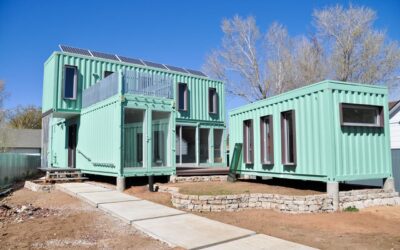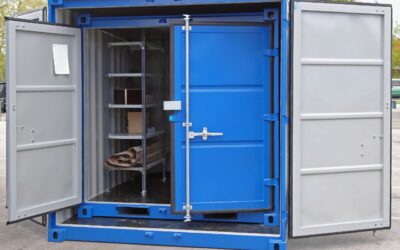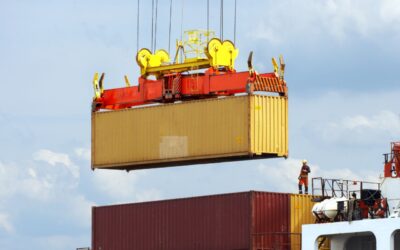Every year, millions of shipping containers make their way around the world for the transport and storage of produce and goods. From a distance, they look like one and the same but there are actually a variety of different sized shipping containers, made to serve different purposes. We thought we’d go through the most common sizes of shipping containers and describe how they each play their part.
20ft Containers
The 20ft container is the standard sized shipping container and one of the most commonly used containers in the world. Although the first shipping containers were seen as early as the 1930s, shipping container sizes weren’t standardised by the International Standards Committee until 1961, at which point, containers like the 20ft container became more prolific. The great advantage of shipping containers was that they enabled the easy loading of goods with limited damage in transit and robust and reliable security.
Today, 20ft containers are made to worldwide standardised dimensions with a length of 6,058 mm, a width of 2,438 mm and a height of 2,591 mm. They weigh approximately 2,060 kg and have a payload of 28,420 kg.
What are 20ft Containers used for?
20ft shipping containers are used in freight for the transport of goods. Each container can fit approximately 10 pallets with each pallet typically holding 60 boxes. This means each 20ft shipping container can amazingly hold up to 600 boxes of goods, a clear indication of just how efficient they are. Interestingly, this also equates to 400 flat-screen TVs, 24,000 tin cans or 48,000 bananas.
Besides freight, they are also commonly used for long-term storage by businesses with surplus goods or additional capacity demands. They are also frequently used for container modification as living spaces, offices spaces, pop-up cafes and kiosks, retail shops and more.
40ft Containers
The 40ft container is another very common sized shipping container and together with the 20ft container make up the overwhelming majority of containers in circulation today. As the name suggests, they’re twice as long as the 20ft shipping container which means twice the capacity. The additional capacity allows producers to obviously fit more goods while at the same time, making it more cost-effective. This is because it’s cheaper to ship one 40ft container than it is to ship two 20ft containers.
40ft containers have a length of 12,200 mm, a width of 2,438mm and a height of 2,591 mm. They weigh 3,510 kg and have a payload of 26,970 kg.
What are 40ft Containers used for?
40ft shipping containers are primarily used by manufacturers and producers of goods, shipping large numbers of products across the world. Each 40ft container can fit approximately 20 pallets with 60 boxes per pallet. This makes a grand total of 1,200 boxes. It is also a popular option for vehicles with 2 – 4 cars able to be secured in a 40ft shipping container.
40ft Containers are also used in modification in larger projects like container homes and residences, site offices, bars, restaurants and retail spaces.
10ft Containers
The 10ft shipping container was actually one of the earliest and most frequently deployed shipping containers starting in the 1930s before 20ft and 40ft became the preferred choice. They have half the capacity of a 20ft container and are more frequently used for private and personal use, for example, for individuals shipping personal possessions from one country to another.
10ft containers have a length of 3029 mm, a width of 2,438mm and a height of 2,591mm. They weigh 1,255 kg and have a payload of 8,095 kg.
What are 10ft Containers used for?
As just mentioned, 10ft containers are frequently used by individuals shipping personal possessions from one country to another who would otherwise be unable to completely fill a 20ft container to capacity. You can fit approximately 300 boxes of goods in a 10ft container which is usually more than enough for this task.
10ft containers have also become very popular in container modification as pop-up kiosks in street fairs, events and festivals. Businesses also used them as temporary storage units during peak seasons of trade.
8ft Containers
The 8ft shipping container is the smallest type of shipping container with an interesting history as one that was used extensively by the US Military in the 1940s. These days it is seen as more of a niche product for private storage, easily transportable with a low footprint while providing ample room for personal belongings.
8ft containers have a length of 2,488 mm, a width of 2,200 mm and a height of 2,260 mm. They weigh approximately 950 kg and have a payload of 5,050kg.
What are 8ft Containers used for?
These days, 8ft containers are mostly used for personal storage. Their smaller dimensions make them perfect for the suburban house or lifestyle property as they can easily fit at the end of a driveway or in the garden somewhere. Garden equipment, tools, potting mix, sports and leisure equipment can all be safely stored away with plenty of room to spare. Like 10ft containers, they are also used in container modifications as information booths, portable cafes, stands for trades fairs etc.
High Cube Containers
High cube containers are different from the containers mentioned previously as they are not a variation of length but a variation of height. Instead of being 2,591 mm in height as a standard, they are 2,896 mm tall or approximately 1ft taller. Both 20ft high cube and 40ft high cube containers are available as high cube shipping containers giving you more space and volume for storage.
For example, a 20ft high cube container has a volume of 37.4m³ compared to a standard 20ft container which has a volume of 33.2m³
What are High Cube Containers used for?
High cube containers are particularly useful for companies shipping bulk goods as the extra capacity allows them to achieve better margins on their freight. This is very beneficial for large quantities of smaller sized goods like electronics, merchandise and other non-perishables. High Cube Containers are also used to transport oversized items that don’t fit in standard-sized containers like some vehicles and machinery.
The most common sized shipping containers explained!
So there you have it. The most common sized shipping containers you’ll find on container ships, in ports, in business premises and even in people’s homes. As you can see, they all have their own functions and uses but are all vital to the safe and secure transport and storage of goods all around the world.









